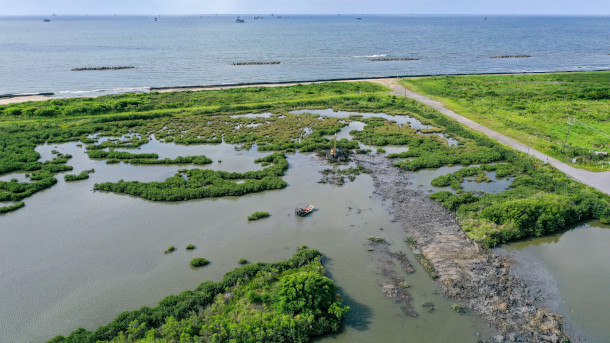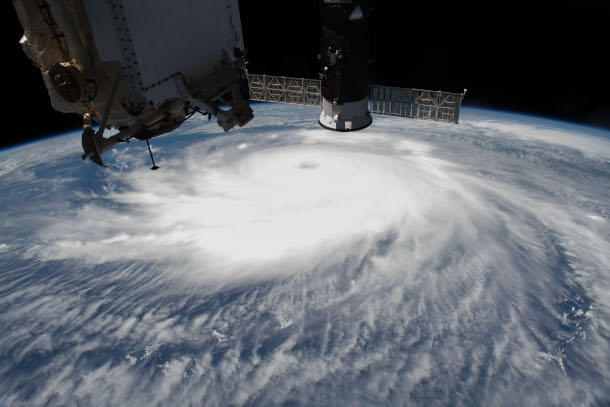Wetlands Mitigate Hurricane Damage
Air Date: Week of September 11, 2020

Louisiana’s wetland ecosystem took the brunt of Hurricane Laura in late August 2020. (Photo: CWPPRA, Costal Wetlands Planning Protection and Restoration Act, Flickr, CC BY-NC-ND 2.0)
Hurricane Laura hit the Gulf Coast as a Category 4 at the end of August 2020, but the impact of the killer hurricane was less deadly than many had feared, in part due to the buffer provided by coastal wetlands. Living on Earth's Aynsley O'Neill reports.
Transcript
DOERING: From fires we turn now to floods. Both are natural disasters scientists tell us will be more frequent and severe with climate change. Hurricane Laura hit Louisiana as a Category 4 storm at the end of August but the killer hurricane was actually less deadly than many feared. Living on Earth’s Aynsley O’Neill has more.
O’NEILL: Hurricane Laura had the strongest sustained windspeed of any hurricane on record to make landfall in Louisiana. And the storm surge was expected to be catastrophic for inland communities. But the damage wasn’t actually all that bad, according to many people in the region, including Governor Greg Abbott of Texas.
GOV. ABBOTT: As I ask everybody how they feel about working their way through this hurricane, everybody pretty much had the same phrase. And that is: we dodged a bullet. It could have been far worse.
O’NEILL: With roughly 70 casualties and about $9 billion dollars in repairs, the loss of life and costs of Laura are only a fraction of what was expected ahead of the hurricane. Mass evacuations certainly saved lives but the biggest life saver was where the storm hit. The hurricane made landfall at the marshes that sit along the Louisiana-Texas border. And on the Gulf Coast, wetlands like those are crucial to protecting inland communities from the natural disasters.

Hurricane Laura, here viewed from the International Space Station, made landfall along the Gulf Coast as a Category 4 hurricane. (Photo: NASA Johnson, Flickr, Public Domain)
When waves come crashing against the shoreline, wetlands absorb the impact and reduce the intensity of the storm surge and flooding. In fact, scientists estimate that every 2.7 miles of coastal wetlands reduce storm surge inland by a foot – so long as that wetland is in good condition. But wetlands are frequently destroyed or degraded for coastal development. Wetlands ecologist and Loyola University professor Bob Thomas says destroying wetlands to build a canal at the end of the Mississippi River was a disaster for the region when it comes to mitigating hurricane damage.
THOMAS: If you would have never built the Mississippi Gulf Outlet, when Katrina came in and all that water was pushed across toward New Orleans most of it would have been absorbed and you would have had maybe one or two feet hit those 17 foot high levees. But instead, it was wide open water, and all that water came in and literally topped over some of the levees.
O’NEILL: It’ll take some time to see how well the wetlands are able to bounce back after Hurricane Laura, but ecologists say we need to protect and support these crucial ecosystem services. They are our first line of defense against deadly hurricanes, provided to us for free from Mother Nature. For Living on Earth, I’m Aynsley O’Neill.
Links
WWL-TV, CBS | “Could Healthy Wetlands Have Blunted Hurricane Laura’s Destruction?”
Living on Earth wants to hear from you!
Living on Earth
62 Calef Highway, Suite 212
Lee, NH 03861
Telephone: 617-287-4121
E-mail: comments@loe.org
Newsletter [Click here]
Donate to Living on Earth!
Living on Earth is an independent media program and relies entirely on contributions from listeners and institutions supporting public service. Please donate now to preserve an independent environmental voice.
NewsletterLiving on Earth offers a weekly delivery of the show's rundown to your mailbox. Sign up for our newsletter today!
 Sailors For The Sea: Be the change you want to sea.
Sailors For The Sea: Be the change you want to sea.
 The Grantham Foundation for the Protection of the Environment: Committed to protecting and improving the health of the global environment.
The Grantham Foundation for the Protection of the Environment: Committed to protecting and improving the health of the global environment.
 Contribute to Living on Earth and receive, as our gift to you, an archival print of one of Mark Seth Lender's extraordinary wildlife photographs. Follow the link to see Mark's current collection of photographs.
Contribute to Living on Earth and receive, as our gift to you, an archival print of one of Mark Seth Lender's extraordinary wildlife photographs. Follow the link to see Mark's current collection of photographs.
 Buy a signed copy of Mark Seth Lender's book Smeagull the Seagull & support Living on Earth
Buy a signed copy of Mark Seth Lender's book Smeagull the Seagull & support Living on Earth

